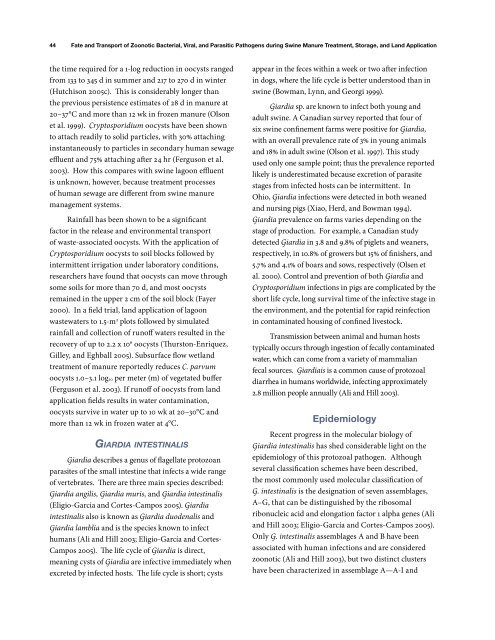Fate and Transport of Zoonotic Bacterial, Viral, and - The Pork Store ...
Fate and Transport of Zoonotic Bacterial, Viral, and - The Pork Store ...
Fate and Transport of Zoonotic Bacterial, Viral, and - The Pork Store ...
Create successful ePaper yourself
Turn your PDF publications into a flip-book with our unique Google optimized e-Paper software.
44<br />
<strong>Fate</strong> <strong>and</strong> <strong>Transport</strong> <strong>of</strong> <strong>Zoonotic</strong> <strong>Bacterial</strong>, <strong>Viral</strong>, <strong>and</strong> Parasitic Pathogens during Swine Manure Treatment, Storage, <strong>and</strong> L<strong>and</strong> Application<br />
the time required for a 1-log reduction in oocysts ranged<br />
from 133 to 345 d in summer <strong>and</strong> 217 to 270 d in winter<br />
(Hutchison 2005c). This is considerably longer than<br />
the previous persistence estimates <strong>of</strong> 28 d in manure at<br />
20–37°C <strong>and</strong> more than 12 wk in frozen manure (Olson<br />
et al. 1999). Cryptosporidium oocysts have been shown<br />
to attach readily to solid particles, with 30% attaching<br />
instantaneously to particles in secondary human sewage<br />
effluent <strong>and</strong> 75% attaching after 24 hr (Ferguson et al.<br />
2003). How this compares with swine lagoon effluent<br />
is unknown, however, because treatment processes<br />
<strong>of</strong> human sewage are different from swine manure<br />
management systems.<br />
Rainfall has been shown to be a significant<br />
factor in the release <strong>and</strong> environmental transport<br />
<strong>of</strong> waste-associated oocysts. With the application <strong>of</strong><br />
Cryptosporidium oocysts to soil blocks followed by<br />
intermittent irrigation under laboratory conditions,<br />
researchers have found that oocysts can move through<br />
some soils for more than 70 d, <strong>and</strong> most oocysts<br />
remained in the upper 2 cm <strong>of</strong> the soil block (Fayer<br />
2000). In a field trial, l<strong>and</strong> application <strong>of</strong> lagoon<br />
wastewaters to 1.5-m 2 plots followed by simulated<br />
rainfall <strong>and</strong> collection <strong>of</strong> run<strong>of</strong>f waters resulted in the<br />
recovery <strong>of</strong> up to 2.2 x 10 6 oocysts (Thurston-Enriquez,<br />
Gilley, <strong>and</strong> Eghball 2005). Subsurface flow wetl<strong>and</strong><br />
treatment <strong>of</strong> manure reportedly reduces C. parvum<br />
oocysts 1.0–3.1 log10 per meter (m) <strong>of</strong> vegetated buffer<br />
(Ferguson et al. 2003). If run<strong>of</strong>f <strong>of</strong> oocysts from l<strong>and</strong><br />
application fields results in water contamination,<br />
oocysts survive in water up to 10 wk at 20–30°C <strong>and</strong><br />
more than 12 wk in frozen water at 4°C.<br />
GiArdiA intestinAlis<br />
Giardia describes a genus <strong>of</strong> flagellate protozoan<br />
parasites <strong>of</strong> the small intestine that infects a wide range<br />
<strong>of</strong> vertebrates. <strong>The</strong>re are three main species described:<br />
Giardia angilis, Giardia muris, <strong>and</strong> Giardia intestinalis<br />
(Eligio-Garcίa <strong>and</strong> Cortes-Campos 2005). Giardia<br />
intestinalis also is known as Giardia duodenalis <strong>and</strong><br />
Giardia lamblia <strong>and</strong> is the species known to infect<br />
humans (Ali <strong>and</strong> Hill 2003; Eligio-Garcίa <strong>and</strong> Cortes-<br />
Campos 2005). <strong>The</strong> life cycle <strong>of</strong> Giardia is direct,<br />
meaning cysts <strong>of</strong> Giardia are infective immediately when<br />
excreted by infected hosts. <strong>The</strong> life cycle is short; cysts<br />
appear in the feces within a week or two after infection<br />
in dogs, where the life cycle is better understood than in<br />
swine (Bowman, Lynn, <strong>and</strong> Georgi 1999).<br />
Giardia sp. are known to infect both young <strong>and</strong><br />
adult swine. A Canadian survey reported that four <strong>of</strong><br />
six swine confinement farms were positive for Giardia,<br />
with an overall prevalence rate <strong>of</strong> 3% in young animals<br />
<strong>and</strong> 18% in adult swine (Olson et al. 1997). This study<br />
used only one sample point; thus the prevalence reported<br />
likely is underestimated because excretion <strong>of</strong> parasite<br />
stages from infected hosts can be intermittent. In<br />
Ohio, Giardia infections were detected in both weaned<br />
<strong>and</strong> nursing pigs (Xiao, Herd, <strong>and</strong> Bowman 1994).<br />
Giardia prevalence on farms varies depending on the<br />
stage <strong>of</strong> production. For example, a Canadian study<br />
detected Giardia in 3.8 <strong>and</strong> 9.8% <strong>of</strong> piglets <strong>and</strong> weaners,<br />
respectively, in 10.8% <strong>of</strong> growers but 15% <strong>of</strong> finishers, <strong>and</strong><br />
5.7% <strong>and</strong> 4.1% <strong>of</strong> boars <strong>and</strong> sows, respectively (Olsen et<br />
al. 2000). Control <strong>and</strong> prevention <strong>of</strong> both Giardia <strong>and</strong><br />
Cryptosporidium infections in pigs are complicated by the<br />
short life cycle, long survival time <strong>of</strong> the infective stage in<br />
the environment, <strong>and</strong> the potential for rapid reinfection<br />
in contaminated housing <strong>of</strong> confined livestock.<br />
Transmission between animal <strong>and</strong> human hosts<br />
typically occurs through ingestion <strong>of</strong> fecally contaminated<br />
water, which can come from a variety <strong>of</strong> mammalian<br />
fecal sources. Giardiais is a common cause <strong>of</strong> protozoal<br />
diarrhea in humans worldwide, infecting approximately<br />
2.8 million people annually (Ali <strong>and</strong> Hill 2003).<br />
Epidemiology<br />
Recent progress in the molecular biology <strong>of</strong><br />
Giardia intestinalis has shed considerable light on the<br />
epidemiology <strong>of</strong> this protozoal pathogen. Although<br />
several classification schemes have been described,<br />
the most commonly used molecular classification <strong>of</strong><br />
G. intestinalis is the designation <strong>of</strong> seven assemblages,<br />
A–G, that can be distinguished by the ribosomal<br />
ribonucleic acid <strong>and</strong> elongation factor 1 alpha genes (Ali<br />
<strong>and</strong> Hill 2003; Eligio-García <strong>and</strong> Cortes-Campos 2005).<br />
Only G. intestinalis assemblages A <strong>and</strong> B have been<br />
associated with human infections <strong>and</strong> are considered<br />
zoonotic (Ali <strong>and</strong> Hill 2003), but two distinct clusters<br />
have been characterized in assemblage A—A-I <strong>and</strong>


